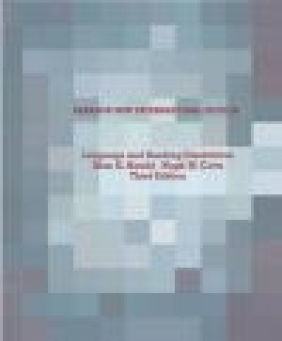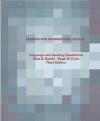Language and Reading Disabilities
Hugh Catts, Alan Kamhi
Language and Reading Disabilities
Hugh Catts, Alan Kamhi
- Producent: Pearson
- Rok produkcji: 2013
- ISBN: 9781292021980
- Ilość stron: 328
- Oprawa: Miękka
Niedostępna
Opis: Language and Reading Disabilities - Hugh Catts, Alan Kamhi
For courses in speech and language intervention, language disorders, reading disorders and special education. Written by leading experts, this third edition maintains a strong clinical focus and thorough coverage of the identification, assessment, and treatment of reading and writing disorders. Fully updated, this edition includes a new chapter on reading comprehension, a new chapter on spelling, and consolidated information on defining and classifying reading disabilities. New sections feature the latest on comprehension development, RTI, auditory processing deficits, literate vocabulary, and cognitive linguistic skills in writing. Offering the varied perspective of well-known contributors, the text successfully keeps pace with the rapid changes in the knowledge of language and reading disabilities and provides readers with the most up-to-date advances in the field.Preface Acknowledgments Contributors and Affiliations CHAPTER 1: Language and Reading: Convergences and Divergences Alan G. Kamhi and Hugh W. Catts Defining Language Phonology Semantics Morphology Syntax Pragmatics Defining Reading Models of Spoken and Written Language Comprehension Comprehending Spoken and Written Language Perceptual Analyses Word Recognition Discourse-Level Processes Differences between Spoken and Written Language Physical Differences Situational Differences Functional Differences Form Differences Vocabulary Differences Grammatical Differences Processing Differences Basic Factors in Reading and Language Development Summary References CHAPTER 2: Reading Development Alan G. Kamhi and Hugh W. Catts Emergent Literacy Period (Birth-Kindergarten) Joint Book Reading Learning about Print Summary The Development of Word Recognition Skills Logographic Stage Alphabetic Stage Orthographic Stage and Automatic Word Recognition Problems with Stage Theories of Word Recognition The Self-Teaching Hypothesis Evaluating the Self-Teaching Hypothesis The Development of Reading Comprehension Misconceptions about Comprehension Development Summary References CHAPTER 3: Defining and Classifying Reading Disabilities Hugh W. Catts, Alan G. Kamhi, and Suzanne A. Adlof Historical Basis of Reading Disabilities Early Reports Orton Johnson and Myklebust The Modern Era Terminology Prevalence Gender Differences Defining Reading Disability Exclusionary Factors IDA Definition Dyslexia as a Specific Learning Disability Problems in Word Recognition and Spelling Deficits in Phonological Processing Unexpected Underachievement Secondary Consequences Classifying Dyslexia and Other Language-Based Reading Difficulties Subtypes Based on the Simple View of Reading Classification Studies Other Subtyping Methods Based on Word Recognition Skills Combining Subtypes in Research and Practice Clinical Implications References CHAPTER 4: Causes of Reading Disabilities Hugh W. Catts, alan G. Kamhi, and Suzanne A. Adlof Extrinsic Causes of Reading Disabilities Early Literacy Experience Reading Instruction Matthew Effects Intrinsic Causes of Reading Disabilities Genetic Basis Neurological Basis Visually-Based Deficits Auditory Processing Deficits Attention-Based Deficits Language-Based Deficits References CHAPTER 5: Assessment and Instruction for Phonemic Awareness and Word Recognition Skills Stephanie Al Otaiba, Marcia L.Kosanovich, and Joseph K. Torgeson Development and Assessment of Phonemic Awareness The Importance of Phonemic Awareness in Learning to Read Purposes for Assessment of Phonemic Awareness Procedures and Measures Used to Assess Phonemic Awareness Development and Assessment of Word Recognition Issues in the Assessment of Word Recognition Commonly Used Measures of Word Recognition Ability Code-focused Classroom Instruction and More Intensive Small-Group Supplemental Intervention What Do We Know about Effective Code-focused Classroom Instruction? What Do We Know about Tier 1 Instructional Strategies that Maximize Reading Outcomes? What Do We Know about Training Code-focused Skills through Supplemental Interventions? What Do We Know about Poor Responders? Issues for Future Research and Development References CHAPTER 6: Spelling Assessment and Intervention: A Multiple Linguistic Approach to Improving Literacy Outcomes Kenn Apel, Julie J. Masterson, and Danielle Brimo The Language Basis of Spelling Phonological Knowledge Orthographic Pattern Knowledge Morphologic Knowledge Semantic Knowledge Mental Graphemic Representations Relation between Spelling and Other Literacy Skills Developmental Spelling Theories Multi-linguistic Approach to Assessment Determining Goals Measuring Progress Multi-Linguistic Approach to Instruction and Intervention Prescriptive, Multi-Linguistic Intervention Improving Orthographic Pattern Knowledge Other Orthographic Pattern Knowledge Strategies Improving Morphological Knowledge Supplementing Language Knowledge Strategies with Word-Specific Learning Tactics Multi-linguistic Instruction at the Classroom Level Summary References CHAPTER 7: Perspectives on Assessing and Improving Reading Comprehension Alan G. Kamhi Defining comprehension Reader Abilities Text Factors Task Factors A Model of Comprehension Assessing Reading Comprehension Comprehension Instruction Strategy Instruction Content Goals and Disciplinary Literacy Summary and Conclusions CHAPTER 8: Assessing and Remediating Text Comprehension Problems Carol E. Westby Cognitive and Linguistic Underpinnings for Literacy Linguistic Skills for Literacy Cognitive Understanding for Text Comprehension Assessing Language and Cognitive Skills for Text Comprehension Assessing Literate Language Style (Text Microstructures) Assessing Knowledge of Narrative Content Schemata and Text Grammar Schemata (Text Macrostructures) Assessing Recognition/Comprehension of Content Schemata Assessing ability to organize schema content and text grammars Facilitating Text Comprehension Developing Linguistic Microstructures Developing Macrostructure Schemas Summary References Children's Materials Appendix A: Books to Develop Connectives/Complex Clauses Appendix B: Cinderella Stories CHAPTER 9: Learning to Write Cheryl M. Scott A Framework for Writing Emergent and Early School Writing: Age 4-8 Years Learning to Write Genre-Specific Text: Ages 9+ Learning the Macrostructure of Writing: Genre Development Interpretation of Genre Studies: Effects of Task and Curriculum Learning the Microstructure of Writing: Sentence Grammar Learning the Process of Writing How Well Do Children Write: Incidence of Writing Disorder and National Assessments Writing, Reading, and Oral Language Summary References CHAPTER 10: Developing Knowledge and Skills for Writing Carol E. Westby Introduction Developing Writing Foundations Production/Transcription Skills Cognitive/Linguistic Skills Exploring the post-modern genre Expository texts Syntactic Structures Summarizing Developing Writing Processes Strategies for Generative Ideas and Planning Strategies for Production Strategies for Revising Summary Children's Books Appendix 10.1 References Index
Producent:
GPSR Pearson Central Europe Sp. z o.o.
ul. Szamocka 8
01-748 Warszawa (PL)
tel: 459 596 060
email: [email protected]
Szczegóły: Language and Reading Disabilities - Hugh Catts, Alan Kamhi
Tytuł: Language and Reading Disabilities
Autor: Hugh Catts, Alan Kamhi
Producent: Pearson
ISBN: 9781292021980
Rok produkcji: 2013
Ilość stron: 328
Oprawa: Miękka
Waga: 0.72 kg






























